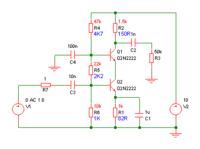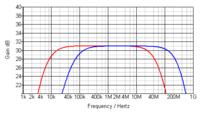Follow along with the video below to see how to install our site as a web app on your home screen.
Note: This feature may not be available in some browsers.


The teacher bought thousands of 2N2222 transistors and tested the hFE of each one to find two with an hFE of 150."β=150" is the sort of idiot thing I've only ever seen in classroom exercises.
I don't think you can meet all the requirements. There's a tradeoff between bandwidth, gain and power consumption. The results of some simulations are shown below.
Yes,It is only a homework assignment.as you said,source and load impedances are unusual.btw, Is this just a homework assignment, or do you actually want to make an amplifier? I ask because the source and load impedances given are extremely unusual, if not completely impractical for an RF circuit. Also, "β=150" is the sort of idiot thing I've only ever seen in classroom exercises.
I aready did.Also,can you attach your simulation details?
Why don't you do the simulation yourself? Surely you have simulation software if your studies require you to do simulation?Yes,It is only a homework assignment...
can you write a procedure (step-by-step) to calculate Bypass and Blocking capacitors in this design?What other details do you want?
Good question, embarassing answer.1. in theory,how do I have to calculate upper 3dB frequency,while high frequency capacitors are related to 2N2222A?in fact,how did you understand theoretically that upper frequency is larger than 40 MHz in this circuit?
That's a difficult question. All the old through-hole high-frequency transistors seem to be obsolete/no longer available. I couldn't find any in the RS online catalog at any rate. They do have a lot of SMD parts which may be suitable, but I,m not familiar with any of them.2. what is your suggestion for the top transistor?which transistor is best for this purpose?
The picture in post 1 says "DC power dissipation: PD < 10mW", so the total power drawn from the power supply must be less than 10mW. Since the supply is 10V, that means the circuit should not draw more than 1mA of current from the supply.what is mean of "Dc power dissipation"?
I agree (and here are some extra characters so the total is more than 10).Don't blindly trust simulation results - some of the transistor SPICE models used are very inaccurate.
Onsemi screwed up on the datasheet. So don't believe everything you see in datasheets either, they sometimes have printing mistakes.
Coming back to to electronics as a hobby after about 20 years, it's sad to see the whole industry moving towards surface-mount parts which I can barely see, let alone solder. And that new-fangled lead-free solder that doesn't work properly, and doesn't look right even when it does work.